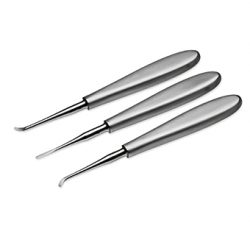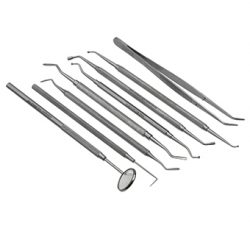Disposable dentistry
Robert Jagger makes the case for single-use hand instruments in general dental practice
A wide range of single-use disposable dental and surgical instruments is now produced by a number of manufacturers. Instruments are available for purchase either singly or as procedure kits and are priced to be a realistic alternative to decontaminating reusable instruments (1).
Paradoxically, single-use instrumentation is rarely seen as a viable alternative by dental professionals who typically associate single use with cheap, unreliable plastic devices and a very limited product range.
In reality, a wide range of high-quality hand instruments are now available from some manufacturers, including mirrors, probes, restorative instruments, endodontic instruments, minor oral surgical instruments and extraction forceps for both adult and paediatric use.
Procedure packs are also available for specific procedures which contain all necessary instruments. Examples of packs include dental and periodontal examination, restorative procedure packs, maxillofacial biopsy, minor oral surgery, and periodontal microsurgery.
This article examines the potential benefits of high-quality single-use instruments in a busy general dental practice and to challenge current clinician perceptions of single-use instrumentation.
Quality
Single-use instruments can be of extremely high quality and may be almost indistinguishable in use from reusable instruments. Clinicians often comment that they are impressed by their quality and functionality, and that they “appear far too good to throw away after just one use”. These instruments are a significant step forward from the poorer quality equipment which was previously available.
Before selecting a supplier of single-use instruments, it is critical to ensure that they comply fully with all relevant British and European medical device regulatory standards, that they are manufactured from medical grade surgical steel and undergo rigorous in-process quality assurance checks and batch testing. Purchasing instruments from a British Dental Industry Association (BDIA)-approved supplier will provide practitioners with assurance that they are dealing with an appropriately regulated manufacturer.
Sterilisation
One of the most significant changes to have affected the dental profession in recent years has been the adoption of rigorous sterilisation and cross-contamination procedures (HTM 01-05 – Decontamination in Primary Care Dental Practices)2.
HTM 01-05 is applicable to Northern Ireland, whereas the Republic of Ireland is currently waiting on a new Dental Act to come into force before their decontamination guidelines
are revised.
Dental practices in Northern Ireland have been informed that best practice recommendations as stated in the Health Technical Memorandum 01-05 should be fully implemented with decontamination and cross-infection control as the main focuses.
Dangers posed by ‘prion diseases’ such as variant Creutzfeldt-Jakob Disease (vCJD) remain even with the most effective dental sterilisation processes. The prion associated with vCJD, is able to survive steam autoclaving at standard exposure conditions3, suggesting that some re-usable surgical instruments are potentially being utilised in a contaminated state. Use of single-use disposable instruments ensures that instruments are not contaminated, protecting patients and clinical staff alike.
Costs
Most general dental practices are now equipped with HTM 01-05 compliant equipment, except for the Republic of Ireland where practices are in the process of doing it. Reprocessing dental instrument trays, however, inevitably leads to significant wear and tear and ultimately instrument damage.
Regular sharpening (and replacement) of re-usable instruments is also necessary for instruments such as luxators, chisels and elevators. This can also add substantial costs to the reprocessing of reusable instruments.
Reprocessing protocols dictate that a dental practice must hold significant stock of expensive reusable instruments, much of which often lies redundant.
Single-use instruments can also provide a cost-effective contingency to cover unexpected emergency situations where reusable instruments may be unavailable – for example when managing unplanned surgical complications, or during times when washer disinfectors/
sterilisers are inoperable and significant clinical time may be lost while waiting for the arrival of a skilled service engineer. Single-use instruments also enable clinicians to accurately forecast “true” procedure costs, as there is no need to take into account the considerable hidden costs associated with the decontamination, sterilisation and packaging of reusable instrumentation.
Convenience
Oral surgery: Single-use packs allow rapid and efficient management of dental extractions which become complicated by, for example, crown fracture. Contingency stock of single-use surgical packs (comprising integral single-use scalpel handle and blade, tissue retractors, periosteal elevator, dental elevators and suture pack) enables highly convenient, efficient and cost-effective management of complications.
Restorative dentistry: Single-use conservation and examination packs provide a cost-effective means of extending the length of daily clinic treatment sessions, especially towards the end of the day, where access to sterile reusable instruments may be compromised due to sterilisation equipment downtime/cleaning routines (when nursing staff are therefore unavailable for clinical duties).
Endodontics: Single-use rubber dam and root canal obturation packs provide optimal cost and clinical efficiencies. Clinicians can more effectively identify and control procedure costs and maximise their return on time-consuming and costly procedures. Safety-conscious patients are increasingly requesting that single-use instruments are used for their treatment because they feel more comfortable if the hand instruments used to perform their procedure are “brand new and have never been used on another patient”. Single-use instruments eliminate infection-prevention concerns associated with the reprocessing of reusable instruments.
Periodontics: Single-use dental scalers provide an efficient solution for dentists, dental hygienists and dental therapists – every instrument is guaranteed to be sharp for every procedure, enabling reduced treatment times, with less patient discomfort.
Periodontal microsurgery: There are periodontal microsurgery packs on the market that are designed to facilitate complex periodontal surgical procedures in a cost effective way, ensuring that instruments are always functional and sterile.
Oral medicine: Soft-tissue biopsy packs provide an ‘off-the-shelf’ sterile, cost-effective solution for performing intra-oral tissue biopsies – particularly in general practice, where these procedures are often performed infrequently.
Implant dentistry: Single-use periotomes and microsurgery packs provide a cost-effective solution for procedures which require precision and speed.
Management of patients with significant medical co-morbidities: Single-use conservation and surgical packs provide an entirely safe and cost-effective means of managing medically vulnerable patients, including those with immuno-compromised conditions, those requiring dental treatment before elective cardiac and renal surgery and pre and post head and neck radiotherapy
and chemotherapy.
- Fig 1 Warwick James elevator set
- Fig 2 Dental conservation pack
Environmental impact
It is often forgotten that decontamination and sterilisation procedures consume large amounts of energy, water, cleaning fluids and consumables, with associated significant environmental impact.
Single-use surgical instruments are designated as a specialist clinical waste stream and as such must be disposed in accordance with UK and European clinical waste management regulations. Historically, this has meant that they were disposed alongside clinical sharps waste, and conveyed to incineration and landfill.
This is no longer necessarily the case, as a recent innovative partnership between Robinson Healthcare, a specialist single-use instrument manufacturer and one of the UK’s largest specialist healthcare waste management companies, Healthcare Environmental Group (HEG), which has led to the development of a unique UK-wide single-use instrument surgical steel recycling programme.
HEG is now able to provide dental practices with a unique reusable ‘Healthcare Sharps’ waste container.
The company has a fleet of dedicated fully regulatory compliant purpose-designed vehicles and the capacity to service individual dental practices and clinics with scheduled waste container collections and deliveries. Containers are tracked from practice to recycling station using GPS technology. Depending on the annual volume of steel recycled, HEG is potentially able to offer a payback to dental practices that adopt the Healthcare Sharps Recycling Service.
Summary
Use of high-quality, single-use instruments can provide significant advantages to dentists in general dental practice. Particular advantages are sterility, convenience, reduced operating costs and efficiencies. Use of packs such as the surgical, restorative, periodontal and implant packs can be particularly helpful.
The purchase costs of the single-use instrument option are less significant when the hidden costs of reusable instruments are considered, and their cost in use is typically significantly less than the reusable instrument option.
Advances in instrument recycling methods have effectively addressed environmental concerns.
About the author
Robert Jagger BDS, MSc, FDSRCS, is a consultant in restorative dentistry at the University of Bristol Dental Hospital and School.
References
1. Puttaiah R, Cederberg R, Youngblood D. A pragmatic approach towards single-use-disposable devices in dentistry. Bull Group Int Rech Sci Stomatol Odontol. 2006; 47: 18-26.
2. HTM 01-05 – “Decontamination in Primary Care Dental Practices, www.gov.uk/government/publications/decontamination-in-primary-care-dental-practices
3. Rutala WA, Weber DJ – Guideline for disinfection and sterilization of prion contaminated medical instruments. Infection Control and Hospital Epidemiology 2010; 31: 107-117.




You must be logged in to post a comment.